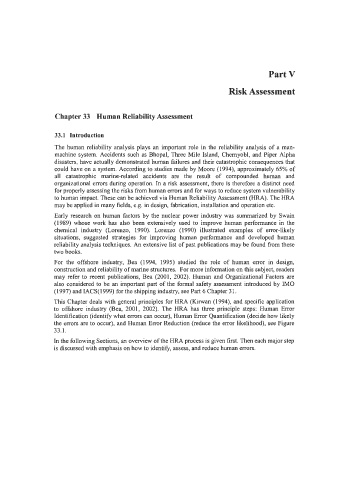Page 603 - Marine Structural Design
P. 603
Part V
Risk Assessment
Chapter 33 Human Reliability Assessment
33.1 Introduction
The human reliability analysis plays an important role in the reliability analysis of a man-
machine system. Accidents such as Bhopal, Three Mile Island, Chernyobl, and Piper Alpha
disasters, have actually demonstrated human failures and their catastrophic consequences that
could have on a system. According to studies made by Moore (1994), approximately 65% of
all catastrophic marine-related accidents are the result of compounded human and
organizational errors during operation. In a risk assessment, there is therefore a distinct need
for properly assessing the risks from human errors and for ways to reduce system vulnerability
to human impact. These can be achieved via Human Reliability Assessment (HRA). The HRA
may be applied in many fields, e.g. in design, fabrication, installation and operation etc.
Early research on human factors by the nuclear power industry was summarized by Swain
(1989) whose work has also been extensively used to improve human performance in the
chemical industry (Lorenzo, 1990). Lorenzo (1990) illustrated examples of error-likely
situations, suggested strategies for improving human performance and developed human
reliability analysis techniques. An extensive list of past publications may be found from these
two books.
For the offshore industry, Bea (1994, 1995) studied the role of human error in design,
construction and reliability of marine structures. For more information on this subject, readers
may refer to recent publications, Bea (2001, 2002). Human and Organizational Factors are
also considered to be an important part of the formal safety assessment introduced by IMO
(1 997) and IACS( 1999) for the shipping industry, see Part 6 Chapter 3 1.
This Chapter deals with general principles for HRA (Kirwan (1994), and specific application
to offshore industry (Bea, 2001, 2002). The HFL4 has three principle steps: Human Error
Identification (identify what errors can occur), Human Error Quantification (decide how likely
the errors are to occur), and Human Error Reduction (reduce the error likelihood), see Figure
33.1.
In the following Sections, an overview of the HRA process is given first. Then each major step
is discussed with emphasis on how to identi@, assess, and reduce human errors.

